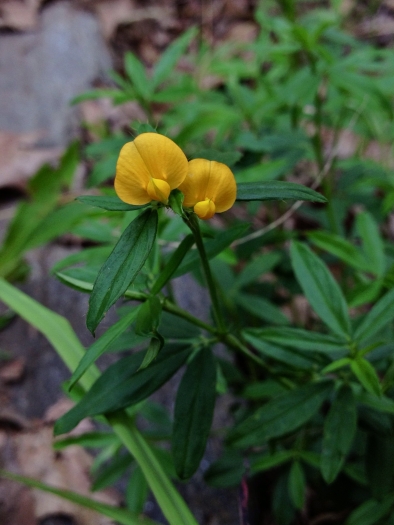Sidebeak Pencilflower
(Stylosanthes biflora)
Sidebeak Pencilflower (Stylosanthes biflora)
/
/

Fritz Flohr Reynolds
CC BY-SA 2.0
Image By:
Fritz Flohr Reynolds
Recorded By:
Copyright:
CC BY-SA 2.0
Copyright Notice:
Photo by: Fritz Flohr Reynolds | License Type: CC BY-SA 2.0 | License URL: https://creativecommons.org/licenses/by-sa/2.0/ | Uploader: FritzFlohrReynolds | Publisher: Flickr |




















































Estimated Native Range
Summary
Stylosanthes biflora, commonly known as Sidebeak Pencilflower, is a deciduous perennial herb native to open woodlands, grasslands, and roadsides in the southeastern United States. It typically grows to a height and width of approximately 2 feet (0.6 meters). The plant has a bushy habit with small, compound leaves and slender stems. It produces distinctive yellow and orange flowers from late spring through fall, which are modest in size but can be quite numerous, adding a splash of color to the landscape.
Sidebeak Pencilflower is valued for its drought tolerance and ability to thrive in a variety of soil conditions, making it a versatile choice for xeriscaping and naturalized areas. It is often used for erosion control, as a ground cover, and in wildflower gardens. This species prefers full sun to part shade and can adapt to a range of soil types, from sandy to loamy, with varying drainage capabilities. While it is not commonly found in nurseries, it can be a useful plant for restoration projects and habitat creation. It is relatively low-maintenance, but can be susceptible to root rot in overly wet conditions.CC BY-SA 4.0
Sidebeak Pencilflower is valued for its drought tolerance and ability to thrive in a variety of soil conditions, making it a versatile choice for xeriscaping and naturalized areas. It is often used for erosion control, as a ground cover, and in wildflower gardens. This species prefers full sun to part shade and can adapt to a range of soil types, from sandy to loamy, with varying drainage capabilities. While it is not commonly found in nurseries, it can be a useful plant for restoration projects and habitat creation. It is relatively low-maintenance, but can be susceptible to root rot in overly wet conditions.CC BY-SA 4.0
Plant Description
- Plant Type: Herb
- Height: 0.4-1 feet
- Width: 1-1.5 feet
- Growth Rate: Moderate
- Flower Color: Yellow, Orange
- Flowering Season: Spring, Summer, Fall
- Leaf Retention: Evergreen
Growth Requirements
- Sun: Full Sun, Part Shade
- Water: Low, Medium
- Drainage: Medium, Fast, Slow
Common Uses
Butterfly Garden, Drought Tolerant, Groundcover, Low Maintenance
Natural Habitat
Native to open woodlands, grasslands, and roadsides in the southeastern United States
Other Names
Common Names: Two-Flower Pencil-Flower, Sidebeak Pencil-Flower, Endbeak Pencilflower, Pencil Flower, Pencil-Flower
Scientific Names: , Stylosanthes biflora, Stylosanthes riparia, Stylosanthes biflora var. hispidissima, Stylosanthes elatior, Stylosanthes floridana, Stylosanthes riparia var. setifera, Stylosanthes riparia f. ochroleuca, Trifolium biflorum, Arachis aprica
GBIF Accepted Name: Stylosanthes biflora (L.) Britton, Sterns & Poggenb.